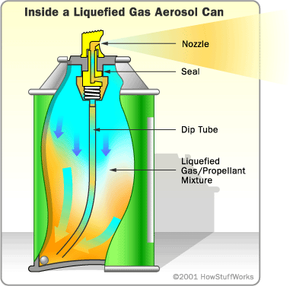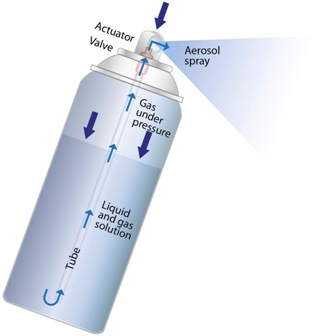Which of the Following Is Not an Aerosol
An aerosol is a colloid of fine solid particles or liquid droplets in air or another gas. Which of the following would not normally be considered an atmospheric aerosol.

Aerosol Dispensers Labelling Youtube Dispenser Labels No Response
Which of the following is not an example of matter.

. Experts are tested by Chegg as specialists in their subject area. The liquid or solid particles have diameter mostly smaller than. Which of the following is not an available formulation strength for fluticasone propionate Flovent by metered dose inhaler.
Examples of natural aerosols are fog geyser steam. The term aerosol describes any suspended solid or liquid particles in the atmosphere. The following is true about bleach as a disinfectant.
Bleach requires a minimum of 2 minutes contact time to reliably kill infectious agents. A 1 part bleach to 9 parts water dilution is the best for general disinfection. A smoke B sea salt C dust D pollen E methane.
Aerosol is a word that is used to describe a mixture of small liquid andor solid particles dispersed in a gaseous system such as air. It comes from the prefix aero meaning air and the suffix sol which is short for the solution. Which of the following lung availabilitytotal systemic availability LT ratios is consistent with an efficient aerosol delivery.
Shape and motion of the particles. We review their content and use your feedback to keep the quality high. Which of the following is not an example of matter.
Water vapor sea salt smoke soil particles. Methane Pollen Smoke FogSmog Dust. All of the following are questions you should consider when selecting an.
Which of the following would not normally be considered an. Bleach works best in the presence of blood or other organic materials. In the absence of photosynthesis the agricultural productivity get decreased.
The primary source of the acidity in acid rain are the gases _____. An aerosol is a colloid of fine particles or liquid droplets in. This problem has been solved.
Fogsmog Viruses Bacteria Pollen Salt-algae. Examples of natural aerosols are fog dust forest exudates and geyser steam. An aerosol is a suspension of fine solid particles or liquid droplets in the air or another gas.
See the answer See the answer See the answer done loading. Spread of bacterial infections. Hazards of aerosol therapy include all of the following EXCEPT.
Which of the following is not an aerosol. Size of the particles. Thus the correct answer is option D.
Which of the following is not an aerosol. Who are the experts. Multiple Choice o air ο light from a candle ο wax ο the propellant in an aerosol can ο a stain on clothing.
Which of the following would not normally be considered an atmospheric aerosol. Bleach is stable for 1 month after dilution. Chemistry questions and answers.
The organisms most commonly associated with contamination of clinical aerosol generators are. Among the given options mud is not an aerosol. Air is matter because it is a form in a gas state light from candle is a matter because the candle body is a solid and if the candle continues to burn through an ongoing cycle it is melted by the heat of the flame and converts it to a liquid state of matter a wax is in a sloid state the propellant in an aerosol can is a matter because it is a form of gas which occupies space with the aide.
Which of the following particles is likely to fall out of the air faster. The correct option is D. It is type of pollutant that hinders the sunlight to reach the plants and thus plants are not able to trap light for photosynthesis.
An aerosol is a colloid of fine solid particles or liquid droplets in the air or another gas. An aerosol is a colloid of fine solid particles or liquid droplets in the air or another gas. Aerosols can be natural or artificial and they can be found in the air over oceans deserts mountains forests ice and every ecosystem in between.
The word aerosol comes to us from aero- which refers to. This problem has been solved. Aerosols can be natural or artificial and they can be found in the air over oceans deserts mountains forests ice and every ecosystem in between.
When aerosol particles leave suspension in gas they deposit on attach to a surface. Which of the following factors affect pulmonary deposition of an aerosol. Fume Dust and Smoke are a solid form of aerosol.
Correct option is D Aerosol is the colloid of fine solid particles in the air such as fog. 2 puffs four times daily. Which of the following is not considered an aerosol.
Chemistry questions and answers. Aerosols can be natural or anthropogenic. Which of the following is not an example of matter.
All of the following are indications for bland aerosol administration except A Bypassed upper airway B COPD C Subglottic edema D Upper airway edema. NOx and N2O H2SO4 and NO. A air B light from a candle C wax D the propellant in an aerosol can.
Which of the following is NOT an example of an aerosol. Mist is a liquid form of aerosol.

Liquid Gas How Aerosol Cans Work Howstuffworks

About Aerosols European Aerosol Federation

Waterdrop Replacement For Filtrete Advanced 3us Pf01 Under Sink Water Filter In 2022 Under Sink Water Filter Sink Water Filter Under Counter Water Filter
Comments
Post a Comment